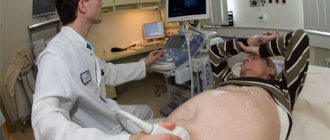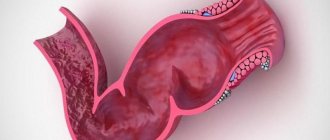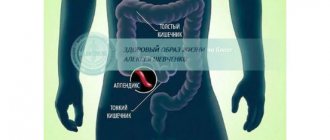• Appendiceal symptoms
Appendiceal symptoms
Shchetkin-Blumberg symptom
The examiner's left palm is placed on the right iliac region and applies pressure to it, then the hand is quickly removed. The symptom is positive if, at the moment of removing the hand from the abdominal wall, severe pain appears in the area being examined. The symptom is positive in other inflammatory diseases of the abdominal cavity. Pain occurs above the site of inflammation.
"Fading soreness" symptom
A diagnostic symptom that allows you to differentiate chronic appendicitis from gastritis. With chronic appendicitis, patients can feel pain only in the epigastric region for a long time and even treat gastritis.
The symptom is as follows: if in chronic appendicitis and (even acute) there is pain on palpation in both the epigastric and right iliac region, or only in the epigastric region, then with one hand press on the painful area in the right iliac region and, at the same time, with the other hand palpate the epigastric region.
In the presence of appendicitis, pain in the epigastric region disappears. As soon as the pressure on the appendicular region is stopped, the pain in the epigastrium is restored.
Sitkovsky's symptom
If a patient with acute appendicitis, lying on his back or on his right side, is turned onto his left side, then the pain in the right iliac region intensifies or, if it was not there, appears. Pain occurs due to displacement of the cecum and inflamed appendix.
Rovzinga symptom
Pressure of the descending segment of the large intestine in the left iliac region causes pain in the right iliac region. Gases, moving through the large intestine, stretch the cecum and thereby, in acute appendicitis, increase pain.
Obraztsov's symptom
Pain during palpation of the right iliac region in acute appendicitis increases if the patient is forced to raise his right leg straightened at the knee joint.
Kocher's symptom
Pain in the navel and epigastric region is an early sign of the onset of acute appendicitis.
Voskresensky symptom
The patient's shirt is pulled on with his left hand, and at the moment of exhalation, the fingertips of the right hand slide along the shirt from the epigastric region to the right iliac region. The hand stops without leaving the abdominal wall. In the presence of acute appendicitis, at the moment the slide ends, the patient notes increased pain in the right iliac region.
Symptom of cough shock
Increased pain when coughing when the right iliac region is pressed with fingers.
Barthomier-Michelson's sign
Pain upon palpation of the cecum intensifies when the patient is positioned on the left side.
Zatler's symptom
In patients in a sitting position, when raising the straightened right leg, pain occurs in the right iliac region.
Liver diseases
Ortner's symptom
Tapping on the right costal arch for diseases of the gallbladder causes sharp pain in the liver area.
Murphy's symptom
When the fingers are deeply pressed into the right hypochondrium during cholecystitis, the patient cannot take a deep breath.
Obraztsov's symptom
Sharp pain when inserting the hand into the area of the right hypochondrium when the patient inhales. The symptom is characteristic of liver and gallbladder disease.
Pancreatic diseases
Mayo-Robson symptom
Pain in the left costovertebral angle when palpating the posterior abdominal wall as a sign of acute pancreatitis. If the lesion is only in the area of the head of the gland, this symptom is negative.
Shchetkin-Blumberg symptom
The examiner's left palm is placed on the right iliac region and applies pressure to it, then the hand is quickly removed. The symptom is positive if, at the moment of removing the hand from the abdominal wall, severe pain appears in the area being examined. The symptom is positive in other inflammatory diseases of the abdominal cavity. Pain occurs above the site of inflammation.
The abdomen is divided into three floors by two horizontal lines: epigastrium, mesogastrium and
hypogastrium , which, in turn, are divided into 9 regions by two vertical lines (along the outer edges of the external abdominal muscles).
Epigastrium: the epigastrium itself, the right and left subcostal regions.
Mesogastrium: periumbilical, right and left lateral areas.
Hypogastrium: suprapubic, right and left iliac regions.
Source: //emhelp.jimdofree.com/%D1%88%D0%BF%D0%B0%D1%80%D0%B3%D0%B0%D0%BB%D0%BA%D0%B8-03/% D1%85%D0%B8%D1%80%D1%83%D1%80%D0%B3%D0%B8%D1%8F/%D0%B0%D0%BF%D0%BF%D0%B5%D0 %BD%D0%B4%D0%B8%D0%BA%D1%83%D0%BB%D1%8F%D1%80%D0%BD%D1%8B%D0%B5-%D1%81%D0% B8%D0%BC%D0%BF%D1%82%D0%BE%D0%BC%D1%8B/
Features of diagnosis in men
Taking into account certain anatomical features of the male body, proprietary tests have been developed for diagnosing appendicitis in men. The following symptoms can be identified:
1 Laroca. Its essence lies in the fact that when the male appendix becomes inflamed, a spontaneous displacement of the right testicle in the upper direction is observed. 2 Horn. If the scrotum is pressed or twitched, then pain of varying intensity is felt in the right testicle. 3 Britten. To identify it, you need to press your hand from the lower abdomen with tense muscles in this area. As a result of the test, the right testicle rises, but after removing the hand it returns to its place.
Symptoms of appendicitis by last name of the authors
Doctors know more than 70 ways to palpate the abdomen to determine pathology. Among them are 40 symptoms characteristic of acute appendicitis and complications of inflammation of the appendix.
What is appendicitis
The appendix is an extension of the cecum, which, when inflamed, is burdened with life-threatening complications.
Acute appendicitis occurs due to:
- blockage of an area of the intestine;
- development of harmful microflora;
- spasm of the walls of the appendix;
- blood stagnation;
- infections;
- overeating;
- diseases of the gastrointestinal tract.
In pregnant women, appendicitis becomes inflamed due to the fact that the enlarged uterus damages the appendix.
The functions of the appendix are varied. Among them are the digestion of food and the effect on intestinal motility. It is believed that the appendix is a vestigial organ and some patients try to inflame appendicitis on their own at home.
Do not do this under any circumstances. According to statistics, people who have had their appendix removed have an increased risk of developing stomach and intestinal cancer. In addition, it is more difficult for people without an appendix to restore intestinal microflora after infections.
Signs of appendicitis in adult men
If appendicitis is suspected, symptoms in adults are as follows:
- Deterioration in health.
- Abdominal pain.
- Weakness.
- Abnormal stool.
- Rapid pulse.
- Nausea and single vomiting.
Scar after appendectomy in a man
The first signs of appendicitis in women
Women more often than men suffer from inflammation of the appendix. In women, appendicitis occurs in the evening or at night. From the first minutes, abdominal pain appears, which shifts to the right iliac region.
With an anatomical anomaly in the location of the appendix, patients complain of pain in:
- lower back;
- groin;
- right hypochondrium.
If the pain suddenly goes away during acute appendicitis, this is a reason for urgent surgery. Dulling of pain is associated with the development of peritonitis, a complication after appendix. With peritonitis, the contents of the stomach enter the peritoneum, and the nerve endings die.
In women, inflammation of the peritoneum is disguised as a gynecological disease
Before surgery to remove the appendix in women, the doctor excludes the possibility of ectopic pregnancy and inflammation of the ovaries, since the symptoms of the diseases are similar.
In pregnant women
Symptoms of inflammation of the appendix in pregnant women are less pronounced than in men and children. Some palpation symptoms do not appear due to stretching of the anterior peritoneal wall by the fetus.
To confirm suspicion of appendicitis in pregnant women, patients are prescribed an ultrasound of the abdomen.
Inflammation in the peritoneum - risk to the fetus
Appendicitis during pregnancy creates a risk of:
- placental abruption.
- infection of amniotic fluid.
- miscarriage.
Symptoms of appendicitis in pregnant women:
- Nausea and vomiting.
- Pain in the lower right corner of the abdomen.
- Heat.
Symptoms of appendicitis in children
Children and adolescents have bodies that are not as strong as adults. Children are a particular risk area: fragile health and the inability to speak complicate the disease. But in infants under 1 year of age, inflammation of appendicitis is rare.
Inflammation develops faster in children than in adults
Most often, appendicitis becomes inflamed in children and adolescents aged 10 to 18 years.
What causes appendicitis in children:
- hypothermia.
- helminthic infestation.
- poor nutrition.
The main symptoms of acute appendicitis in children:
- wandering pain in the abdomen.
- My right side hurts and I feel nauseous.
- the temperature rises.
- weakness, shortness of breath, rapid pulse.
How it hurts
In the first minutes, inflammation of the appendix is accompanied by heaviness near the navel or in the right side in the iliac region. The person cannot straighten up and walking is difficult. The pain is dulled only when lying down - all these are signs of inflammation.
Abdominal pain preventing you from walking? Call a doctor at home
Acute appendicitis
Pain during appendicitis provokes spasm and swelling of the walls of the appendix. Without the help of doctors, after the stage with acute pain, tissue necrosis occurs - necrosis. The walls of the appendix perforate, and gangrenous-perforated appendicitis develops.
In the catarrhal (first) stage, the pain is sharp and intense. The nature of the pain is aching. Accompanied by heaviness in the abdomen and cutting pain in the right side.
Symptoms of chronic appendicitis
From acute to chronic appendicitis develops after appendectomy if the stump of the appendix continues to periodically become inflamed. Doctors diagnose a relapse of the disease.
Symptoms that accompany chronic appendicitis in adults:
- right side hurts after eating;
- sometimes the pain radiates to the leg or lower back;
- nausea, vomiting;
- diarrhea or constipation;
- pain during bowel movements;
- painful sexual intercourse.
Unlike acute inflammation, patients do not complain of weakness and malaise. Chronic appendicitis in women is often confused with gynecological diseases.
Diagnostics
During the initial examination, doctors palpate the patient’s abdomen to identify surgical pathology of the gastrointestinal tract. By observing the body's reaction to palpation, the doctor diagnoses a suspected disease.
Ultrasound is a popular method for diagnosing abdominal diseases.
After the examination, the patient is sent for examinations to confirm or refute the diagnosis. Or to the operating table, if delay is life-threatening.
Kocher-Wolkovich sign
Symptom of wandering pain. It consists of observing the movement of pain from the epigastric region to the lower right side.
Diagram showing how pain moves
It is considered the main symptom of acute appendicitis.
Source: //LechyZhivot.ru/kishechnik/appendiks/simptomy-appenditsita-po-familiyam
Primary diagnosis of acute manifestations
Most often, appendicitis is of the acute variety, characterized by an unexpected onset, rapid progression and obvious expression of the symptoms of the disease. Only 1-1.5% of all cases are chronic, when the inflammatory process develops over a long period of time, manifesting itself in the form of periodic exacerbations and attacks.
The following author's symptoms are most often recognized as the basis for diagnosing acute appendicitis in Russian medical practice:
1 Kocher's sign. Its use in primary diagnosis is most common. Kocher's symptom also received another name - a symptom of painful migration. It is based on a gradual shift of the painful manifestation from the epigastric zone to the lower, right part of the abdomen (iliac region). The probability that appendicitis is the cause of this symptom exceeds 50%. 2 Voskresensky's sign or signs of abdominal irritation. To diagnose, a simple test is performed: the fabric of the shirt is stretched in the abdominal area, and then, in the longitudinal direction, a quick movement of the edge of the palm is ensured. If an inflammatory reaction occurs in the appendix, then a painful sensation will be detected in the iliac zone on the right. Similarly, other organs located in this part of the body can be tested, and the painful syndrome will change its focus accordingly. 3 Shchetkin-Blumberg symptom. It is considered a reliable indicator of the development of peritonitis, and not only with pathology of the appendix. According to the Shchetkin-Blumberg method, the hand, palm down, is placed on the anterior wall of the peritoneum. Light, slow pressure is applied and the hand is raised sharply. Appendicitis manifests itself as sharp pain in the corresponding area of the iliac zone. 4 Rovsing's symptom. Despite the rather rare use of the technique, it is considered quite reliable and is based on pain syndrome with gas pressure in the cecum. This effect is artificially created as follows. The patient is placed on his back. Using one hand, the doctor presses on the colon (in the lower cavity of the abdomen on the left), and with the other he provides pushes a little higher. If pain appears in the right iliac region, appendicitis can be diagnosed.
Female characteristics
In female representatives, specific signs of appendicitis can also be identified. They should be taken into account, because inflammation of the appendix in some cases is very similar to the manifestation of certain gynecological diseases. Additional testing helps differentiate the pathology in question from other female problems.
The following author's characteristics can be distinguished:
1 Promptova. The gynecologist, conducting examinations of the vagina, moves the cervix back and forth. The appearance of pain excludes the presence of appendicitis and indicates a gynecological disease. 2 Zhendrinsky. The test is carried out by pressing a finger on the point located below the navel, i.e. Kümmel point. Pain syndrome appears. If the pain intensifies when standing up, appendicitis may be suspected. When the pain subsides, gynecological causes should be sought. 3 Brando. In women during pregnancy, pressing on a rib on the left side of the body causes a painful sensation on the right side.
Additional Research
In addition to the manifestations listed above, appendicitis can be pre-diagnosed in other ways. In particular, the following symptoms are often identified according to the authors:
- Aaron's symptom: pain and a bursting feeling in the epigastric zone is generated by finger pressure at McBurney's point.
- Barthomier's symptom: increasing pain when palpating the cecum when the patient lies on his left side.
- Bassler's symptom: increased pain when approaching the bone during palpation in the direction from the navel to the ilium.
- Widmer's symptom: the presence of a temperature difference in the axillary zones, and in the right cavity the local temperature is higher than on the left.
- Dolinov's syndrome: retraction of the abdomen leads to increased pain in the iliac region.
- Krymov's symptom: the occurrence of pain upon palpation in the area of the external opening of the inguinal canal on the right.
- Pshewalski's symptom: difficulty raising the right leg (discomfort, pain).
- Razdolsky's symptom: percussive examination of the abdominal wall reveals pain in the right lower abdomen.
- Sumner's symptom: even mild palpation of the abdomen leads to increased muscle tone in the abdominal wall.
- Chugaev's symptom: identification of the “appendicitis string” - the appearance of a tense state of the oblique muscle during palpation in the area of the anterior wall of the peritoneum.
- Yaure's symptom: pain occurs when pressing at the location of Petit's triangle.











